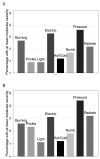Neuropathic features of joint pain: a community-based study
- PMID: 23553508
- PMCID: PMC3701477
- DOI: 10.1002/art.37962
Neuropathic features of joint pain: a community-based study
Abstract
Objective: Quantitative sensory testing (QST) and questionnaire-based assessments have been used to demonstrate features of neuropathic pain in subjects with musculoskeletal pain. However, their direct relationship has not been investigated in the community. The purpose of this study was to conduct an observational study to describe the characteristics of joint pain and to examine the relationship between QST measures and the PainDETECT Questionnaire (PD-Q).
Methods: Warm detection, heat pain, and mechanical pain thresholds as well as mechanical pain sensitivity over the sternum were determined and the PD-Q scores were calculated in a cross-sectional study of 462 participants in the Chingford Study. Comparisons were made between subjects with and those without joint pain. Logistic regression modeling was used to describe the association between neuropathic pain features, as determined by the PD-Q score, and each of the QST measures individually, adjusting for age, body mass index, and use of pain-modifying medications.
Results: A total of 66.2% of the subjects reported recent joint pain, with a median average pain severity of 5 of 10. There was increased sensitivity to painful stimuli in the group with pain as compared to the pain-free group, and this persisted after stratification by pain-modifying medication use. While only 6.7% of subjects had possible neuropathic pain features and 1.9% likely neuropathic pain features according to the standard PD-Q thresholds, features of neuropathic pain were common and were present in >50% of those reporting pain of at least moderate severity. Heat pain thresholds and mechanical pain sensitivity were significantly associated with features of neuropathic pain identified using the PD-Q, with an odds ratio (OR) of 0.88 (95% confidence interval [95% CI] 0.79-0.97; P = 0.011) and an OR of 1.24 (95% CI 1.04-1.48; P = 0.018), respectively.
Conclusion: QST measures and the PD-Q identified features of neuropathic pain in subjects in this community-based study, with significant overlap between the findings of the two techniques.
Copyright © 2013 by the American College of Rheumatology.
Figures



References
-
- Brown ST, Kirkpatrick MK, Swanson MS, McKenzie IL. Pain experience of the elderly. Pain management nursing : official journal of the American Society of Pain Management Nurses. 2011;12(4):190–6. - PubMed
-
- Cimmino MA, Ferrone C, Cutolo M. Epidemiology of chronic musculoskeletal pain. Best practice & research. Clinical rheumatology. 2011;25(2):173–83. - PubMed
-
- Arendt-Nielsen L, Graven-Nielsen T. Translational musculoskeletal pain research. Best practice & research. Clinical rheumatology. 2011;25(2):209–26. - PubMed
-
- Carli G, Suman AL, Biasi G, Marcolongo R. Reactivity to superficial and deep stimuli in patients with chronic musculoskeletal pain. Pain. 2002;100(3):259–69. - PubMed
-
- Arendt-Nielsen L, Graven-Nielsen T. Central sensitization in fibromyalgia and other musculoskeletal disorders. Curr Pain Headache Rep. 2003;7(5):355–61. - PubMed
Publication types
MeSH terms
Grants and funding
LinkOut - more resources
Full Text Sources
Other Literature Sources

